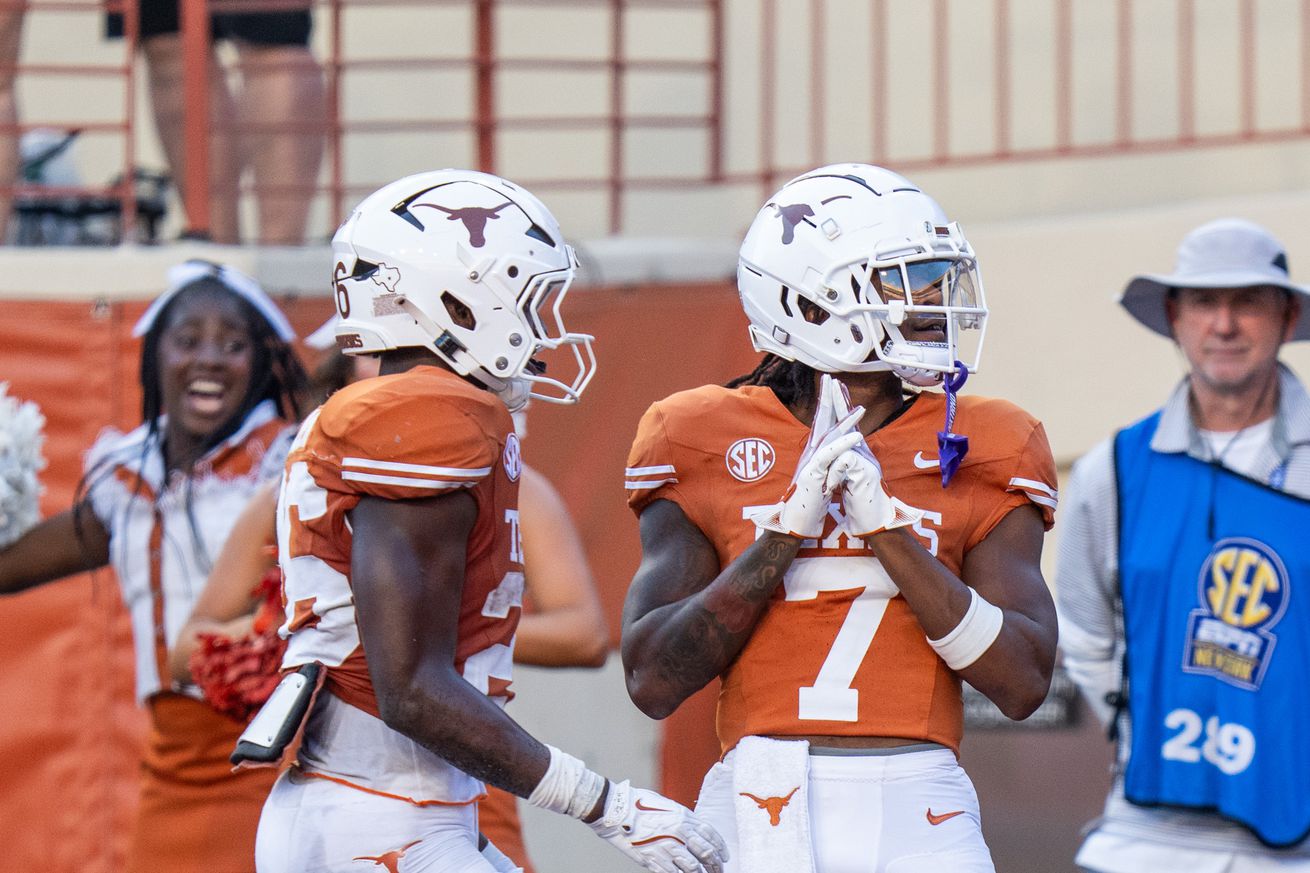
Through five games, assessing how the Longhorns skill players match up against their peers.
The No. 2 Texas Longhorns are in the season’s first bye week after a 5-0 start, including last Saturday’s SEC opener, a 35-13 win over the Mississippi State Bulldogs, so it’s time to look at some season trends heading into the trip to the Cotton Bowl on Oct. 12.
Receiving
Texas currently ranks second in the SEC in PFF receiving grade behind Ole Miss and sixth in the nation. I wanted to take a deep dive to look at how the top targets on each team in the SEC have fared so far this season. I limited the data to just the SEC because it provides an easy enough sample size to see both good and bad teams while also providing us with enough examples for healthy comparisons. We can also then determine how the Texas receiver room is doing, plus identify some threats the Horns may need to figure out how to get a lock on for matchups later on in the season.
Each graph showcases the top receivers by number of targets in that specific receiving depth, and then separated down by the number of those targets that were reeled in. The number at the end of the bar represents yards per route run (YPRR). The reason to use this instead of let’s say a simple yards per game — or even yards per catch — is that it standardizes the usage rate of the receiver given the offense they are in, and it scales pretty nicely with their volume. This is also useful to separate the YPC leaders in terms of efficiency. For instance, they could be great on the very few catches they have, but are not frequently open. For reference as we go along, generally a YPRR value of 10.5 on all catches would put a receiver around the 50th percentile, 14.4 would put them in the top quartile, and 21.2 would put them in the top five percent (95th percentile).
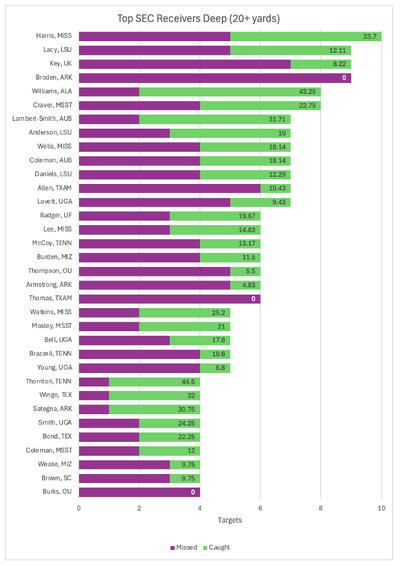
First off, Texas wide receivers Isaiah Bond and Ryan Wingo have caught the most deep balls so far this year for the Horns. Furthermore, Wingo and fellow stellar freshman Ryan Williams, the budding Alabama star, lead the nation in YPRR in the 20-plus yard range. The only player ranked higher than them is senior Dont’e Thornton from Tennessee who has a stunning 242 yards on just seven receptions this year. At Missouri, Tre Harris has taken over as what is possibly the most popular X receiver in an offense from Luther Burden III. Dane Key has struggled deep, but part of that can be blamed on weak quarterback play from Brock Vandagriff in Kentucky. Mississippi State’s Mario Craver was doing well on the season, but only recorded one catch against Texas last week, albeit for 46 yards.
Although Georgia doesn’t have a single receiver that matches the production Ladd McConkey had last year, we should definitely highlight the number of guys they believe are deep threats — Dominic Lovett, Colbie Young, Dillon Bell, and Arian Smith have all recorded multiple catches when targeted 20 yards downfield and teams will continue to find it tough to have enough defensive backs to match up with them when they are in an empty set.
Brenen Thompson and Deion Burks are players I will also highlight next week in the Oklahoma preview, but they have had the least success in passing the deep ball. Whether this is an issue with their receivers, struggling quarterback play, poor coaching, or scheme is tough to determine.
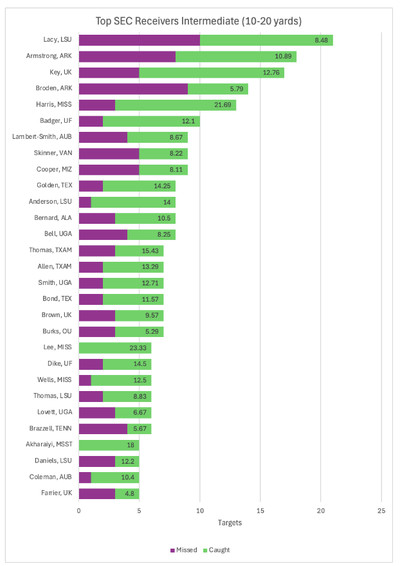
We’ve already caught some great glimpses of Golden being able to find the gaps between zone coverages. He also isn’t even solely relying on his speed, as he’s had a couple of impressive contested catches as well. The only two players doing better efficiency wise in this area are Harris and Cayden Lee from Ole Miss. Jaxson Dart also excels at passing here, but the Rebels look to bounce back after the disappointing home loss to Kentucky. Another interesting note is that despite Alabama’s explosive offense, they rank last in their attempts to the intermediate area with Germie Bernard receiving four targets four and Williams just three.
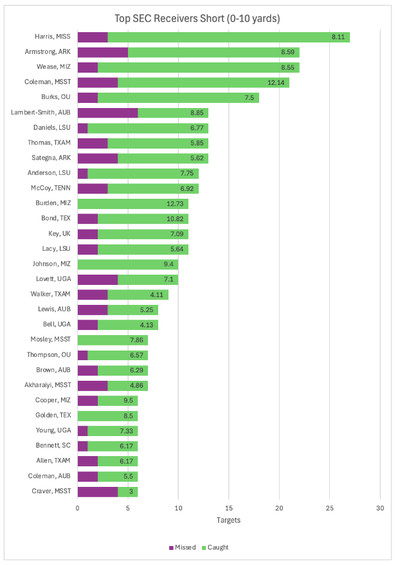
Bond and Golden have the highest average NFL passer rating of any wide receiver duo in the nation when targeted in the short game at 141. What aids them is their yards after the catch with 7.6 per reception for Bond and 4.2 for Golden.
Arkansas might have the most dangerous quick slant and out duo with Andrew Armstrong and Isaiah Sategna. They have gone a combined 20-of-35 receiving in the short game, racking up 13 first downs, plus they are 5-of-5 on winning contested catches here. LSU, a decent candidate for wide receiver U in the past decade alongside Ohio State, has three solid receivers to aid Garrett Nussmeier — CJ Daniels, Aaron Anderson, and Kyren Lacy have caught an extraordinary combined 32-of-36 receptions in the 10-yard range, along with forcing 13 missed tackles after these receptions as well.
Mississippi State’s Kevin Coleman recorded six catches for 57 yards against Texas, which is just under his usual production on the season. The Horns have certainly caused a lot of havoc this year, but this felt like possibly the best WR1 they have faced thus far and weren’t able to severely dampen him. Burks has seen many targets at this depth for Oklahoma, but as noted before, his efficiency is much lower than other leaders here.
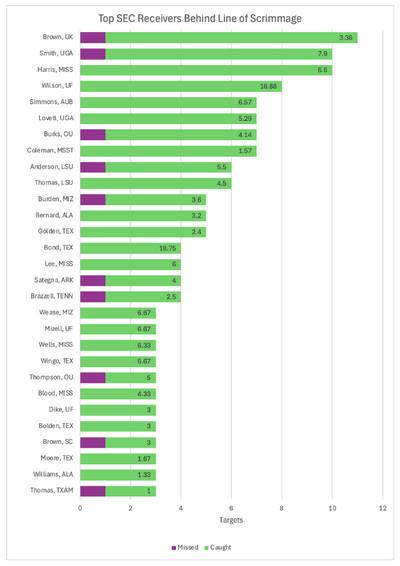
Bond’s YPRR here is not only insane for passes that are starting out with negative yardage, but he would rank in the 85th percentile in YPRR amongst ALL receivers on ALL catches with just his targets here, proving how crucially important the screen game and RPO has been in Sark’s gameplan. We also see Texas wide receiver Silas Bolden make his first appearance, as he hasn’t seen as many snaps as anticipated on offense.
Eugene Wilson has had an equally great performance thus far with screen passes, but he is used almost exclusively in the short and screen game because of Florida’s struggles at the quarterback position. We can definitely give him some kudos to his ability with the ball in his hands, but Bond is no doubt the more well-rounded receiver.
Secondary
On the other side of the ball, I have touched on the improved secondary for Texas but haven’t taken the time for an investigation yet. The Longhorns rank FIRST amongst all 134 FBS teams in pass coverage grading via PFF so far this season. Similarly, I wanted to assess which key players from the Texas secondary are contributing this phenomenal rating, while also pointing out some future opponents who may spell trouble.
I started out the data analysis in a similar way I did the receivers, looking at completions versus incompletions for the highest-targeted defensive backs. I realized as I went through this that cornerback Malik Muhammad and safety Andrew Mukuba weren’t showing up in the areas I anticipated them to be in. It’s like when Richard Sherman’s interceptions had a drastic downturn after he led the league the previous season. Many people thought it was a fluke, but quarterbacks simply refused to pass in his direction.
To correct for this, I also added targets per snaps in coverage to get a more accurate assessment of how much of a threat the defensive backs are in their respective games, (better players will float towards the top right).
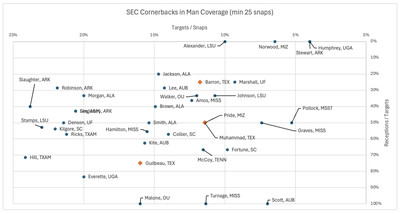
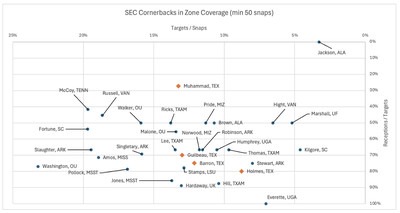
Opposing quarterbacks haven’t really had the chance to throw in Jahdae Barron or Malik Muhammad’s direction this season given the increasing havoc generated up front. In those instances, they have allowed a combined three receptions on eight targets when in man coverage. Jaylon Guilbeau has had big shoes to fill in the slot, as Barron moved to the field corner position.
Although there were some concerns on Bama’s defense going into this season, they have boasted a tremendous secondary every year, and it continues. Bama, South Carolina, and Auburn have their corners playing the most amount of snaps in man (upwards of 60 per game).
Julian Humphrey of Georgia and Kee’yon Stewart of Arkansas appear to be the best in man so far this year, but they also barely made the cut of minimum snaps required. I was curious how this correlates with PFF’s grades which have O’Donnell Fortune of South Carolina, Kayin Lee of Auburn, and Zy Alexander of LSU as the top three in this situation. The Gator duo of Aaron Gates and Jason Marshall Jr. could be the sleepers on Texas’ remaining schedule.
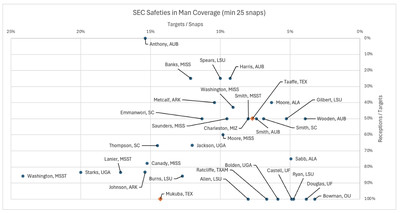
Not too often that safeties are left on islands, but given those circumstances, Mukuba has allowed all four targets to be caught. However, the yards per catch for those receptions was just one yard, an impressive accomplishment that leads me to believe these were on short down situations with a man blitz in which Mukuba was told to play more conservative as there would be no one behind him if he to tackle if he over pursued the ball. Meanwhile, Michael Taaffe has had a remarkable story and is cementing himself as one of the hardest-hitting safeties in the nation, along with providing top-tier coverage.
Although the data is limited, Mukuba and Taaffe are the highest-graded safety duo in the SEC and amongst all Power Four teams. The Rebels have Yam Banks and Trey Washington as a close second. Malachi Moore was listed as a preseason favorite for best safety in the nation and has so far lived up to that expectation for Alabama.
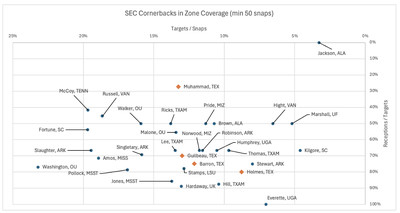
Muhammad has become everything we could have possibly wanted him to be. The Texas corners play more heavily in zone coverage and he has only allowed three catches on 11 targets for 3.7 yards per catch. Surprisingly, neither Muhammad nor Alabama’s Ja’Keem Jackson are the highest-graded corners in zone — Tennessee’s Jermod McCoy ranks first (also first nationwide) and Barron ranks second (fourth nationwide), though Barron has played 99 snaps in zone while McCoy has played 61. Nationally, the only corner duo better than Muhammad and Barron here are Fortune and Kilgore in South Carolina.
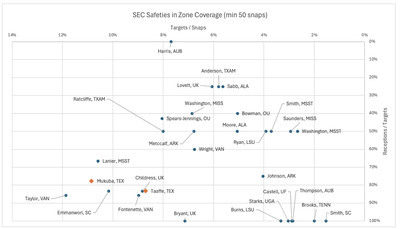
Mukuba has been targeted 10 times on 83 snaps in zone, allowing five catches and 13.2 yards per catch. Taaffe has been targeted five times on 69 snaps, allowing four catches but just 1.3 yards per catch.
Georgia’s Malaki Starks was another preseason favorite amongst top safeties but he has struggled so far in both man and zone coverage. Of the remaining duos the Horns face, the Razorbacks’ Jayden Johnson and TJ Metcalf are the highest rated, tallying a combined three interceptions and three pass breakups through their first five games.
Random thought of the week
Another note on the insane game from last week, Georgia is 45-3 since 2021 and 1-3 against Alabama. It’s almost as if they should be forced to play high-caliber teams en route to the playoffs, so thank god for the new SEC format and getting rid of divisions. It still irks me that they can get away with playing neutral site games in Atlanta, though, I feel like that’s the equivalent of asking Texas to play out-of-state opponents at the Alamodome.